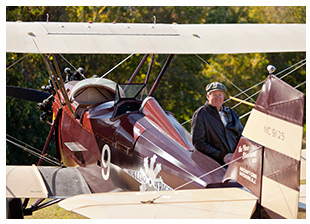Training Tips
|

Preparing for next week's cross-country flight, you study several possible destinations, noting their runway bearings and lengths, airspace class, communications frequencies, and other key details. Your instructor moves the process along by asking you to extract information about each from your study resources.
"Is there an attendant on duty at La Grange, Texas, at 8 p.m.?" she asks you. "If not, can we buy fuel? How would you turn up the runway lights? Are there any unusual traffic considerations to know about? What is a GCO?"
Reviewing the airport/facility directory (A/FD) listing for the Fayette Regional Air Center in La Grange, you look up answers. It's daylight saving time these days, so local time is UTC minus five hours. (Find that information on the listing's top line.) At 8 p.m., it is 0100Z; the airport attendant will have gone home. But fuel is available with a credit card.
The preset intensity for runway lights is low. A pilot can change the intensity on the common traffic advisory frequency, 122.7 MHz. (Check out the Air Safety Institute's safety quiz, Airport Lighting: VFR.) Runway 16/34 seems to have no unusual considerations such as a displaced threshold or a nonstandard traffic pattern, and it has precision approach path indicators to both approach ends.
"Do you see anything else?"
The question speaks for itself, so checking further, you find the answer in a note after the airport remarks: "See Special Notices—Aerobatic Practice Area."
How do you find out more about that?
The notation "See Special Notices" in an airport listing is detailed in the Special Notices section of the A/FD. (If you are reviewing the online A/FD, click the link shown under the heading VOL/BACK PAGES to bring up the information.)
There you find this cautionary information: "Aerobatic flight activity will be conducted within a 2 NM radius of the Fayette Regional Airport (3T5), from 900 feet MSL up to and including 4,000 feet MSL. The practice area is for waiver holders only. Pilots should use caution when operating within this area."
As for GCO, the directory's legend explains that it is a ground communications outlet, usable at some nontowered airports to contact air traffic control or flight service. The GCO also provides a way to close your VFR flight plan and activate the one filed for your next leg—a westbound flight to San Marcos Municipal Airport for the AOPA Regional Fly-in.
|
|
Flight Training News
|
|
Article
Cessna Pilot Centers will be the main flight training provider for students enrolled in Liberty University's online aeronautics bachelor's degree.
Read more...
Share:
 
Article
Piper and Continental have teamed to produce a diesel-powered Archer designed for the international flight training market. The first Archer DX has been flying in Germany since February, and European regulators have approved the 155-horsepower Centurion engine change as a supplemental type certificate.
Read more...
Share:
 
Article
Former FAA Administrator Randy Babbitt, Women Airforce Service Pilot Bernice Haydu, and Sun 'n Fun founding director Billy Henderson were among the recipients of the FAA's Wright Brothers Master Pilot and Charles Taylor Master Mechanic awards.
Read more...
Share:
 
Personality quiz
Of all the pioneering general aviation aircraft ever produced, which model are you meant to fly? The AOPA Aircraft Personality Quiz matches you with the perfect aircraft for your style, temperament, and aviation ambitions. Strap in, enjoy the ride, and let the result astonish you. Then share it with your friends.
Take the quiz...
Share:
 
Apps of the week
Give your plastic checklist an upgrade by going digital with these five apps.
Read more...
Share:
 
NASA's Minority University Research and Education Project has signed approximately $2 million in new cooperative agreements to three tribal colleges and universities to engage students and faculty in NASA-related science, technology, engineering, and mathematics (STEM) activities. The selected institutions for 2014 are Haskell Indian Nations University, Lawrence, Kan.; Southwest Indian Polytechnic Institute, Albuquerque, N.M.; and Chief Dull Knife College, Lame Deer, Mont.
The Institute for Aerospace Education, a science, technology, engineering, and mathematics (STEM) education initiative that serves school districts in Kentucky and Tennessee, has received a $25,000 sponsorship from Kentucky's Frankfort Independent Schools, reports General Aviation News. The institute provides industry certificates and dual college credit in flight/aeronautics, aircraft maintenance, aerospace engineering, and aviation operations/management for students enrolled in its programs.

Video
Words matter when the fuel gauge points to empty. In "Ask ATC: Minimum Fuel vs. Fuel Emergency," air traffic controllers explain that what you say is as important as when you say it.
Watch the video...
Share:
 
Flash-based, login required
Do you use all the benefits flight service can provide, including its help while airborne? The Air Safety Institute's A Pilot's Guide to Flight Service helps you get the most out of flight service, on the ground and aloft, including in-flight weather updates and emergency assistance.
Take the course...
AOPA Stay Smart webinar
Flight school owners can learn how to attract and keep high-quality flight instructors in a Flight School Business webinar with FAA Designated Pilot Examiner Jason Blair on April 15 at 8 p.m. Eastern Daylight Time.
Register now...
Share:
 
|
Training Resources
|
|
PDF
When we think about the risks associated with aviation fuel, the first thing that usually comes to mind is the possibility of a fuel exhaustion incident—an engine failure and subsequent forced landing. That concern is not unwarranted: An average of nearly three aircraft per week are damaged due to fuel exhaustion or starvation. Running out of gas is not, however, the only fuel-related worry for pilots. Read more in this Air Safety Institute safety brief.
Download the brief...
|
|
Did you know that student pilots who join AOPA are three times more likely to complete their flight training? Membership includes unlimited access to aviation information by phone (800/USA-AOPA, weekdays from 8:30 a.m. to 8 p.m. Eastern time) or from Flight Training Online or AOPA Online. If you're not already a member, join today and get the pilot's edge.
|
AOPA Live
|
|
AOPA Live This Week
Fat Albert, the U.S. Navy Blue Angels' C-130 Hercules, is no ordinary cargo hauler. Ride along on this wild flight with AOPA Live's Paul Harrop. Also this week, master craftsmen John and Scott Shue, a father-son team, take AOPA behind the scenes of their award-winning Waco restorations.
AOPA Live This Week®, April 10...
Share:
 
|
|
Career Pilot
|
|
American Eagle Airlines has signed a deal with San Diego Christian College that gives aviation students a direct path to become a commercial airline pilot. Graduates of the college's aviation program will provide flight training for two years, and then be guaranteed an interview with Eagle's parent company, American Airlines.
|
|
For more aviation career news, see the Flight Training website.
|
Plane Spotter
|

If ever an airplane were built to barnstorm, the New Standard D-25 was it—and in selected cases, still is. The sight of one draws you closer, at which point you become aware of how large this Roaring Twenties-era biplane really is; any lingering doubts will be arrested should four passengers disembark from the deep cockpit in front of the pilot. A visually striking feature, to help a plane spotter confirm the identification from a distance, is the difference in size between the large upper and smaller lower wings.
|
Training Products
|
|
John and Martha King of King Schools released a free e-book at Sun 'n Fun for those interested in becoming a private pilot. So You Want to Learn to Fly is written in a fun, easy-to-read style, and topics include choosing the right airplane and flight instructor, understanding FAA requirements to become a private pilot, and which books and other resources are worth the money. The free book can be downloaded from the King Schools website.
Author David Lombardo explains the inner workings of an aircraft in his book, Aircraft Systems. The book includes detailed descriptions and numerous illustrations of the various systems common to general aviation singles and light twins. Readers will gain a greater understanding of what goes on under the cowling and behind the panel. The cost is $29.99.
|
|
Note: Products listed have not been evaluated by ePilot editors unless otherwise noted. AOPA assumes no responsibility for products or services listed or for claims or actions by manufacturers or vendors.
|
Member Benefits
|
|
Members only
Placards provide necessary information to aid in the safe operation of aircraft. The use of placards in accordance with the regulations also provides pilots an opportunity to go flying when certain instruments or equipment don't work.
Read more...
Share:
 
Member benefits
When it comes to flying club insurance, each member should be an "insured" under the policy and be provided cross-liability protection, among other things.
Read more...
Share:
 
|
Blogs
|
|
Still searching for a new flight school, Jean Moule lands in Independence, Ore., and flies her very first Grumman.
Read more...
Share:
 
|
Instrument Tip
|
|
IFR Fix
The clouds were angry, but the passenger was angrier. Bowing to the bluster, a Cessna 421 pilot tried to shoot a gap between cells.
Read more...
Share:
 
|
Final Exam
|
Question
I've read that restricted areas aren't always active and there may be times when pilots can fly through them without permission from the controlling agency. Where can I find this information?
Answer
This information can be found on the end panel of the sectional chart where the restricted area is charted. It is always a good idea to check notams to be sure the restricted area has not been activated outside of its published times.
|
|
Got a question for our technical services staff? Contact AOPA.
|
Career Opportunities
|
|
AOPA career opportunities
Ever dream of turning your passion for aviation into a career? We're looking for an executive assistant for government affairs, account manager I, Air Safety Institute intern, director of state government affairs, account manager II, and member services representative. To learn more about other AOPA career opportunities,
visit AOPA Online.
|
 |
Education and Seminars
|
Flight Instructor Refresher Courses
Apr 12-13 - Atlanta, Ga.; Waltham, Mass.; Salt Lake City, Utah; and Ashburn, Va.
May 3-4 - Fort Lauderdale, Fla.; Albany, N.Y.; and Pensacola, Fla.
May 17-18 - Sacramento, Calif.; Kansas City, Mo.; and Houston, Texas.
June 7-8 - Santa Clara, Calif.; and Ashburn, Va.
For a complete schedule, see AOPA Online. Can't make it in person? Sign up for the Air Safety Institute's new Online eFIRC.
|
Air Safety Institute Safety Seminars
Apr 14 - Pittsburgh, Pa.; and Duluth, Minn.
Apr 15 - Harrisburg, Pa.; and Brooklyn Park, Minn.
Apr 16 - Allentown, Pa.; West Lafayette, Ind.; and Saint Paul, Minn.
Apr 17 - King of Prussia, Pa.; and Rochester, Minn.
Topics vary—for details and a complete schedule, see AOPA Online.
|
Rusty Pilot Seminars
Apr 12 - Dunkirk, N.Y.
Apr 15 - Dunkirk, N.Y.
Apr 25 - San Marcos, Texas
For a complete schedule, see AOPA Online.
|
|
Aviation Calendar
|
|
Want something to do this weekend? Planning an aviation getaway? See AOPA's enhanced calendar of events. Now you can filter events by date range, airport ID, state, or region. Before you take off on an adventure, make sure you check our current aviation weather provided by Jeppesen.
To include an event or to search all events in the calendar, visit AOPA Online. For airport details, including FBO fuel prices, see AOPA Airports.
AOPA Featured Events
Apr 26 — San Marcos, Texas. San Marcos Municipal Airport (KHYI). AOPA Fly-In.
May 31 — Indianapolis, Indiana. Indianapolis Regional Airport (KMQJ). AOPA Fly-In.
Jul 12 — Plymouth, Massachusetts. Plymouth Airport (KPYM). AOPA Fly-In.
Aug 16 — Spokane, Washington. Spokane Felts Field (KSFF). AOPA Fly-In.
Sep 20 — Chino, California. Chino Airport (KCNO). AOPA Fly-In.
Oct 4 — Frederick, Maryland. Frederick Municipal Airport (KFDK). AOPA Homecoming.
Nov 8 — Brunswick, Georgia. Malcom McKinnon Airport (KSSI). AOPA Fly-In.
|
|
|
|
 |
|
|
ePilot Flight Training Editor:
Benét Wilson
Production Assistant:
Melissa Whitehouse |
Contributors:
Sarah Deener
Alyssa Miller
Jim Moore
Jill W. Tallman
Warren Morningstar
Alton K. Marsh
Dave Hirschman
Tom Horne
Ian J. Twombly
Dan Namowitz |
|
|
|
|